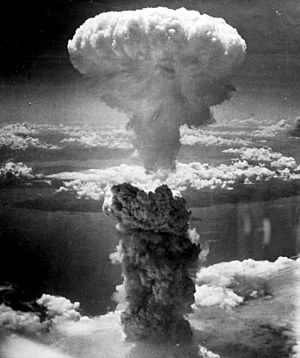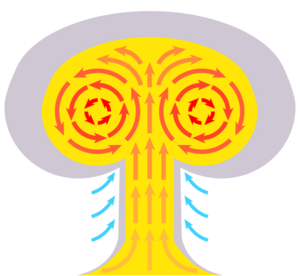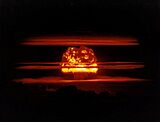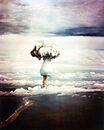Mushroom cloud facts for kids
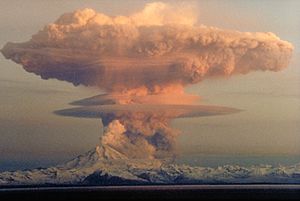
A mushroom cloud is a special cloud shaped like a mushroom. It forms after a very big explosion. This cloud is made of smoke, dust, and often water vapor. While it's most famous for nuclear explosions, other powerful blasts can also create them.
For example, strong conventional weapons (like very big bombs) can make mushroom clouds. Even natural events like some volcanic eruptions or impact events (when something hits the Earth hard) can cause them.
Mushroom clouds happen because a large amount of hot, light gas suddenly forms. This hot gas rises very quickly, like a hot-air balloon. As it rises, it creates swirling air currents around its edges. These currents pull up more smoke, dust, or water vapor from below, forming the "stem" of the mushroom. The cloud keeps rising until it reaches a height where it's no longer lighter than the air around it. Then, it spreads out, creating the "cap" of the mushroom.
Contents
History of Mushroom Clouds
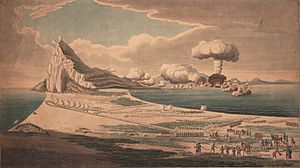
Even though the term "mushroom cloud" became popular in the 1950s, people saw and described these clouds centuries earlier. For instance, in 1782, during the Great Siege of Gibraltar, a picture showed a floating battery exploding with a mushroom-shaped cloud.
In 1798, a scientist named Gerhard Vieth wrote about a cloud near Gotha that looked "not unlike a mushroom in shape." This was seen on a warm summer afternoon and seemed to cause a storm.
Other big explosions also created mushroom clouds before the atomic age. The 1917 Halifax Explosion produced one. In 1937, a newspaper reported a Japanese attack on Shanghai, China, that made "a great mushroom of smoke." During World War II, the sinking of the Japanese battleship Yamato also created a mushroom cloud.
After the atomic bombings of Japan in 1945, the term became widely known. The Times newspaper described the cloud over Nagasaki as a "huge mushroom of smoke and dust." A reporter who saw the Nagasaki bombing said it created a "giant mushroom" that rose very high.
In 1946, during nuclear bomb tests called Operation Crossroads, some people called the clouds "cauliflower" clouds. But soon, the "mushroom" shape became the main symbol of the atomic age.
How Mushroom Clouds Form
Mushroom clouds form from large explosions, especially nuclear ones, because of Earth's gravity. If there were no gravity or a very thin atmosphere, the gases from an explosion would just stay in a ball shape.
Nuclear weapons are usually set off above the ground. This helps spread their powerful blast wave and fireball as much as possible. Right after the explosion, a super hot fireball forms and starts to rise quickly, just like a hot-air balloon.
As the hot gas rises, cooler, heavier air rushes in from below. This creates strong upward air currents, sometimes called "afterwinds." Inside the top part of the cloud, the hot gases spin around in a donut shape. If the explosion happens close to the ground, these afterwinds pull up dirt and debris from the ground. This dirt and debris form the "stem" of the mushroom cloud.
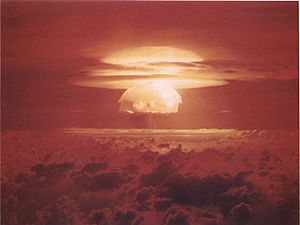
Once the hot gases reach a certain height where they are no longer lighter than the surrounding air, they stop rising. At this point, the cloud starts to flatten out, creating the wide, flat "cap" that gives it its mushroom shape.
Nuclear Explosions and Clouds
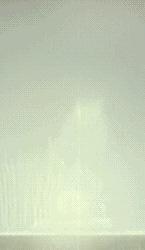
When a nuclear bomb explodes, a super hot fireball appears. This fireball changes shape as it rises and cools. It spins violently, pulling in cooler air. This process creates strong winds that suck up more air, cooling the fireball even more. As it cools, the gases become visible, forming the cloud. The cloud keeps rising until it reaches a stable height in the atmosphere.
When the cloud reaches the tropopause (the boundary between the lower and upper atmosphere), it tends to slow down and spread out. If the explosion is powerful enough, the central part of the cloud can even push higher into the stratosphere. As the air in the cloud rises, it cools, and any water vapor in it turns into tiny water droplets or ice crystals. This process releases heat, which helps the cloud rise even higher.
The head of a nuclear mushroom cloud contains tiny radioactive particles. These particles are mostly from the bomb itself and can be carried by the wind. Sometimes, rain can bring these particles down to the ground, which is called nuclear fallout. Over time, the water droplets in the cloud evaporate, making the cloud seem to disappear. However, the radioactive particles remain in the air and can still cause fallout.
A mushroom cloud goes through several stages:
- Early time: The first 20 seconds, when the fireball forms and mixes with material from the ground.
- Rise and stabilization: From 20 seconds to about 10 minutes, when the hot gases rise and larger fallout particles start to fall.
- Late time: Up to about 2 days later, when the particles are spread by wind, fall due to gravity, or are washed down by rain.
The shape of the cloud is affected by the wind and air conditions. The initial color of some radioactive clouds can be reddish-brown. This is because of gases like nitrogen dioxide, which form from the air in the extreme heat. Later, the cloud becomes white as water condenses, or dark if it sucks up a lot of smoke and debris.
The amount of radiation in the cloud depends on the bomb's power, its type, and where it exploded. Generally, smaller explosions have most of their radioactivity in the cloud's head. Larger explosions tend to have more radioactivity in the lower part of the cloud. Fallout can look like dry, ash-like flakes or be too small to see. If it's invisible, rain often brings it down.
Different Types of Detonations
The way a mushroom cloud looks also depends on where the bomb explodes:
- Air bursts: If a bomb explodes high in the air, it creates less dust and debris. The stem of the mushroom cloud will look white and steamy.
- Surface bursts: If a bomb explodes on or very near the ground, it sucks up a lot of dirt, dust, and soil. This makes the stem look gray or brown. Surface bursts also create more radioactive fallout because they pick up irradiated material from the ground.
- No stem: A bomb detonated very high above the ground might create a mushroom cloud without a visible stem.
- Double mushroom: Sometimes, two mushroom cloud heads can form, one after the other.
- Underground/Underwater: If a bomb explodes deep underground or underwater, it usually doesn't create a mushroom cloud. Instead, it might create a large bubble that collapses or a pillar of water.
What's Inside the Cloud?
The cloud contains three main things:
- What's left of the bomb itself and its radioactive parts.
- Material from the ground, if the explosion was close to the surface.
- Water vapor from the air.
Most of the radiation in the cloud comes from the bomb's radioactive parts. When a bomb explodes, it creates tiny particles. Some are very small and can stay in the air for a long time, spreading widely. Larger particles, especially from ground explosions, fall faster and closer to the blast site.
The radioactivity of these particles decreases over time. The most dangerous, short-lived radioactive materials decay quickly. Longer-lasting radioactive materials, like caesium-137 and strontium-90, are a concern for a longer time.
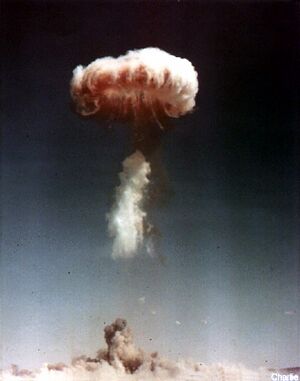
The particles can travel far. For example, radiation from the first atomic bomb test (Trinity) was found in Illinois because a rainstorm washed it down. Also, unexpected winds carried dangerous fallout from the Castle Bravo test to nearby islands, forcing people to evacuate.
Glowing Clouds
In the first few seconds after a nuclear blast, the intense radiation can make the air glow. This is a blue-violet-purple glow caused by ionized oxygen and nitrogen around the forming mushroom cloud. It's easiest to see at night and quickly fades after a few tens of seconds.
Condensation Effects
Nuclear mushroom clouds often have other temporary clouds around them, called "condensation clouds" or "Wilson clouds." These form because the powerful shock wave from the explosion causes a sudden drop in air pressure. This pressure drop makes the air temperature fall quickly, causing water vapor in the air to condense into visible droplets. As the pressure and temperature return to normal, these clouds disappear.
This is similar to the clouds you sometimes see over the wings of jet aircraft. The fast-moving air over the wing creates lower pressure, which cools the air and makes water vapor condense into a visible cloud.
The shape of these condensation clouds can be complex. They can form rings around the fireball or even "skirts" and "bells" around the stem of the mushroom cloud. Sometimes, "ice caps" can form on top of the cloud, similar to scarf clouds, when warm, humid air is pushed high into cold air.
-
The mushroom cloud from the 15-megaton Castle Bravo hydrogen bomb test, showing multiple condensation rings, March 1, 1954.
-
The mushroom cloud from the 11-megaton Castle Romeo hydrogen bomb test, showing a prominent condensation ring.
See also
- Rope trick effect


